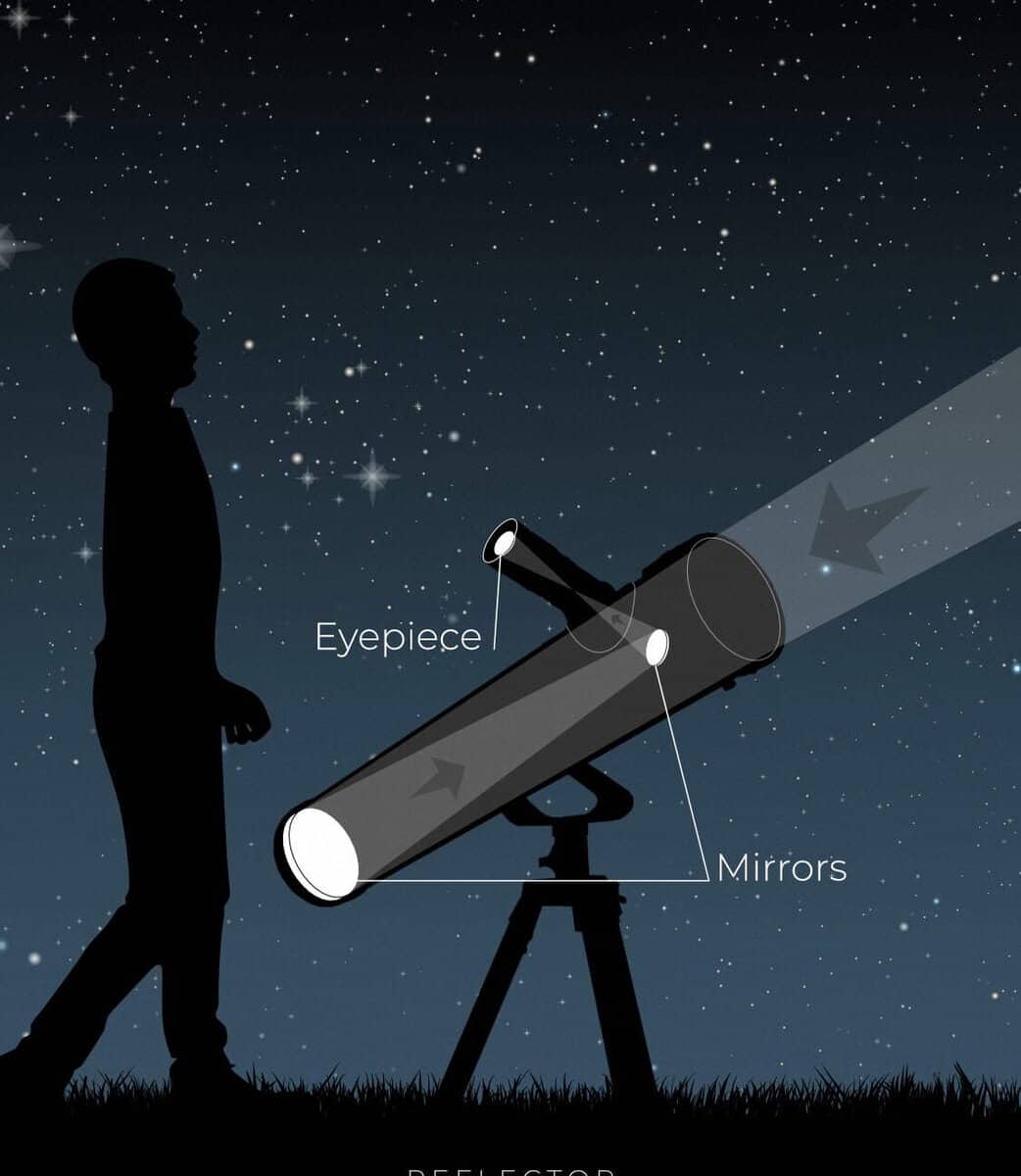A reflector telescope is a device used to amplify the size of faraway objects or to increase the intensity of point objects like stars. A basic refractor telescope is composed of two convex lenses: an objective lens and an eyepiece. The objective lens creates the true image of the distant object in its focal plane. In a typical arrangement, a viewer peering through the eyepiece witnesses an enlarged, virtual representation of the actual object.
The more the telescope lens is widened, the greater the amount of light that can be collected from an object such as a star, allowing for the observation of dim stars that would not be visible with a narrower lens. Additionally, increasing the width of the lens enables the capture of more detailed images of extended objects. In the case of large optical telescopes, a wide concave mirror is utilized as the lens to focus light. This choice is based on the fact that it is easier to manufacture and use large mirrors compared to large lenses. A small mirror positioned near the focal point of the concave mirror is employed to redirect light into the eyepiece. The use of a concave mirror instead of convex lenses helps eliminate chromatic aberration in the lens. Furthermore, if the concave mirror is shaped in a parabolic manner, it also eliminates spherical aberration.
For further information, refer to the articles on Eyepiece and the Hubble Space Telescope.
What sets refractors apart from reflectors?
When it comes to optical telescopes, the key component is the lens. Its purpose is to gather and concentrate the rays emanating from the observed object. Depending on the lens type, telescopes can be categorized as refractors or reflectors.
TELESCOPES 2: CAPABILITY AND POTENCY
TELESCOPES 2: CAPABILITY AND POTENCY The primary features of any telescope are the size of the entrance opening D (the size of the lens or mirror) and the length of focus fo, which determine the relative opening A = D/fo, frequently referred to as the potency of the opening.
TELESCOPES 3: Resolving Power
The resolving power of a telescope refers to its ability to distinguish the smallest angle between two lines of sight aimed at two point objects, such as two closely positioned stars. For instance, if a telescope struggles to differentiate between the two
Methods of exploring the universe. Telescopes. Origins
Approaches to studying the cosmos. Telescopes. Insights into their historical development. In the 15th century, Thomas Digges, an astronomer, made an attempt to construct a telescope-like apparatus using a convex lens and a concave mirror. Nevertheless, his efforts remained unfinished. Hans Lipperschlei (1570-1619), a Dutch scientist, successfully implemented
REFLECTORS.
Reflectors are commonly employed in lighting to redirect existing light in a desired direction, creating a reflex effect. Unlike light sources, reflectors do not emit light on their own; rather, they simply reflect the incoming light. This process produces a gradation of light shades, resulting in a subtle and controlled lighting effect.
A mirror telescope, also known as a reflector, is an optical instrument designed to gather and focus light using a mirror. These telescopes feature a concave mirror with a reflective coating on its front surface. The mirror can be either spherical or parabolic in shape, with the latter being preferred for larger telescopes to prevent loss of image contrast. Spherical mirrors cause the light to not converge to a single point in larger telescopes. The first reflector telescope was developed by Isaac Newton in the 17th century, and the Newtonian reflector system remains popular in modern telescopes. However, there are other optical systems used in mirror telescopes, which we will discuss further.
The Newton telescope is characterized by its simple structure and is considered the most basic type of telescope. It consists of a main mirror that can be either parabolic or spherical in shape, depending on the size of the relative aperture. Near the focus of the main mirror, a flat diagonal mirror is positioned at a 45-degree angle, deflecting the beam of light upwards. However, one drawback of the Newton telescope is that the image it produces is inverted.
In contrast, the Gregory telescope differs from the Newton telescope in several ways. Instead of a flat diagonal mirror, it utilizes an elliptical mirror to reflect the light beam into the eyepiece. This eyepiece is located in the center aperture of the main mirror. Notably, the elliptical mirror in the Gregory telescope is positioned behind the focus of the main mirror, resulting in a direct image.
The Cassegrain telescope shares a similar structure with the Gregory telescope, but with a few key differences. In the Cassegrain design, the secondary convex mirror is positioned near the focus of the main concave mirror, rather than behind it. Additionally, the total focal length of the objective lens is longer than that of the main mirror. These modifications result in a shorter telescope tube length compared to the Gregory telescope, as well as reduced shielding.
Another variation of the Cassegrain telescope is the Ritchie-Cretien system, which has been modernized. This system features a concave hyperbolic primary mirror and a convex hyperbolic secondary mirror. The Ritchie-Cretien design effectively corrects for spherical aberration and coma.
Brachites. This telescope features an external secondary mirror that is positioned outside the beam that falls on the primary mirror. The mirrors have a unique shape, resembling off-axis hyperboloid paraboloids. By tilting the secondary mirror, any astigmatism that may occur with this design can be compensated for. One of the peculiarities of this telescope is that the light beam is not shielded, resulting in images with excellent sharpness and contrast.
Mersenne telescope. What sets this telescope apart is that the focal points of the main and secondary mirrors are combined. Both mirrors are concave parabolic in shape. When light hits the main mirror, it converges to its focal point, and is then intercepted by the secondary mirror, which is positioned behind the focus. The secondary mirror directs the light beam into the central hole of the main mirror.
Another type of reflector is the Nesmith telescope, which is essentially a modified version of the Cassegrain telescope. The Nesmith telescope includes an extra flat mirror positioned between the primary and secondary mirrors. This additional mirror redirects the light beam towards the side of the tube, eliminating the requirement for a hole in the primary mirror.
Article author:
Julia Galetich
Date of publication: 17.12.2010
Unauthorized reproduction without an active hyperlink is strictly prohibited.
While reflector telescopes can have other types of optical aberrations, they are capable of accommodating large diameter objectives, making them a popular choice in astronomical research. Various designs of reflector telescopes exist, and some may incorporate additional optical elements to enhance image quality or optimize the image’s mechanical placement.
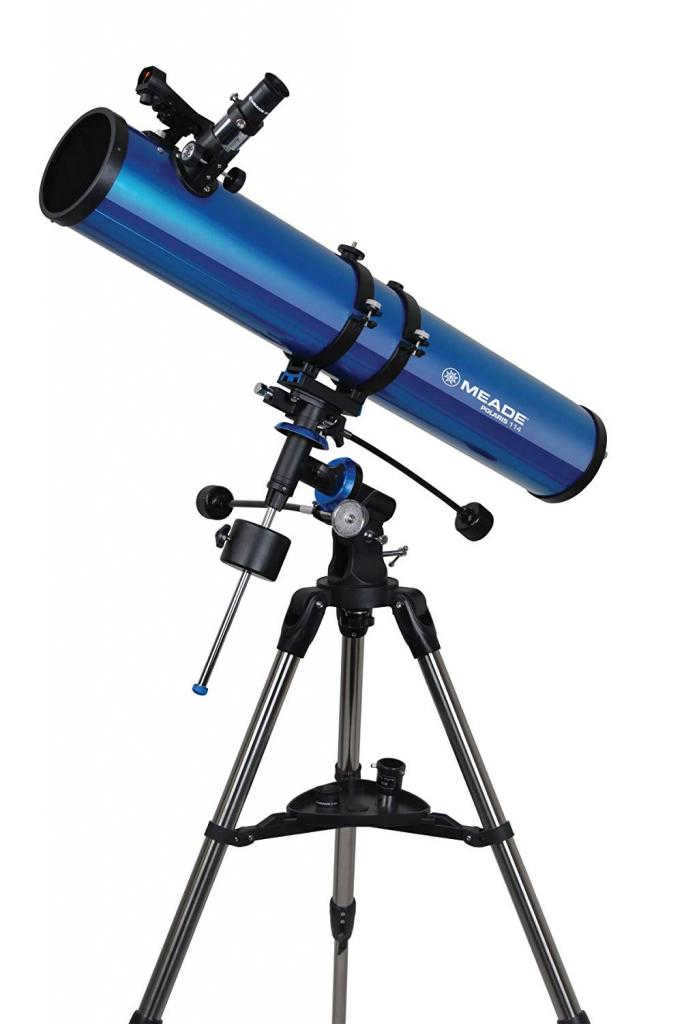
Exploring Reflecting Telescopes
The concept of curved mirrors acting like lenses can be traced back to Alfazen’s tenth-century study on optics, a piece of work that gained popularity through its Latin translations in early modern Europe. Shortly after the development of refracting telescopes, Galileo, Giovanni Francesco Sagredo, and other scientists, drawing from their knowledge of curved mirrors, discussed the possibility of constructing a telescope that uses a mirror as an image-forming instrument. It was reported that Bolognese Cesare Caravaggi constructed the first reflecting telescope around 1626. On the other hand, Italian professor Niccolò Zucci mentioned in a later publication that he experimented with a concave bronze mirror in 1616, but it failed to produce a satisfactory image.
Origins of Invention
The invention of the refractor-reflector telescope is often attributed to Isaac Newton, who is said to have developed it in 1668. This groundbreaking device employed a primary mirror crafted from spherical metal, along with a compact diagonal mirror, forming an innovative optical layout that would later be referred to as the Newtonian telescope.
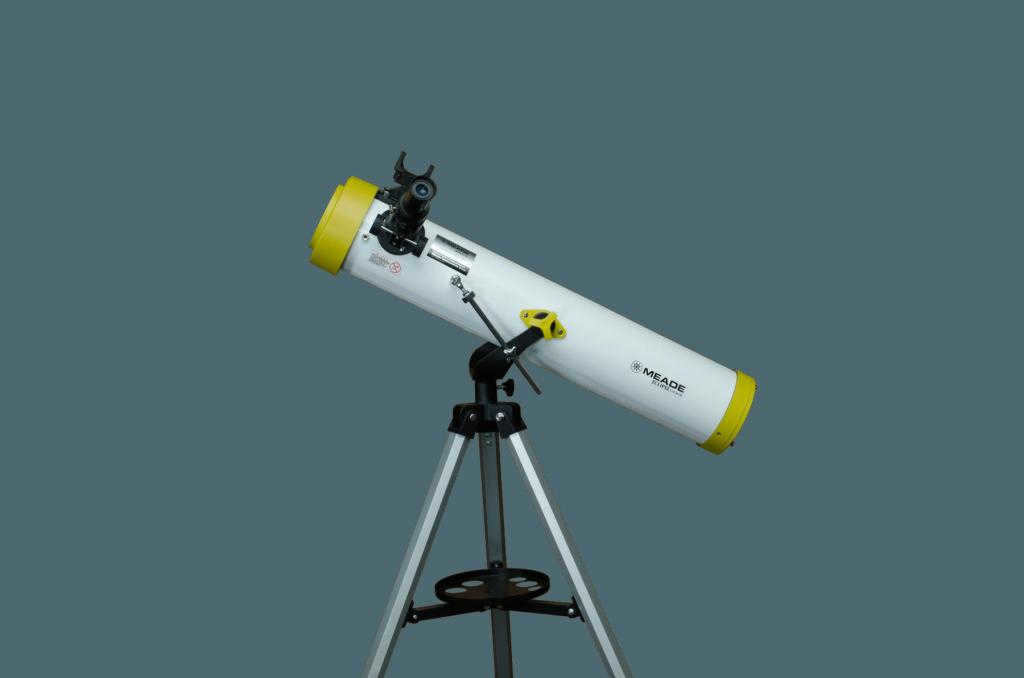
Advancement in the Field
Despite the initial benefits of the reflector design, the complexity of construction and the underwhelming performance of the metal mirrors used during that time period meant that it took more than a century for them to gain popularity. Over the years, various advancements were made in the design of reflector telescopes, including improvements in the fabrication of parabolic mirrors in the 18th century, the introduction of silver-coated glass mirrors in the 19th century, the development of durable aluminum coatings in the 20th century, the use of segmented mirrors to achieve larger diameters, and the implementation of active optics to compensate for gravitational deformation. One notable innovation from the mid-twentieth century was the catadioptric telescope, such as the Schmidt camera, which utilizes both a spherical mirror and a lens (known as a corrector plate) as its primary optical elements. These telescopes are primarily employed for large-scale imaging tasks, offering superior performance without spherical aberration.
During the latter part of the 20th century, the emergence of adaptive optics and the achievement of effective imaging techniques to address challenges in observation and telescope reflection have become pervasive in space telescopes and various spacecraft imaging devices.

The primary component of the telescope that is responsible for creating the image at the focal plane is the curved primary mirror. The focal length is the distance between the mirror and the focal plane. At the focal plane, there may be a digital sensor to capture the image, or an extra mirror can be included to modify the optical properties and redirect light towards the film, digital sensor, or eyepiece for visual examination.
Detailed description
In the majority of contemporary telescopes, the primary mirror is composed of a solid glass cylinder that has been shaped into a spherical or parabolic form on its front surface. To create a mirror that reflects light, a thin layer of aluminum is applied to the lens through a vacuum process, forming a first surface mirror.
There are some telescopes that utilize primary mirrors manufactured in a different manner. The glass is melted and then spun, resulting in a paraboloidal surface. Once the glass has cooled and hardened, the mirror takes on an approximate paraboloidal shape, requiring only minimal grinding and polishing to achieve the desired level of accuracy.
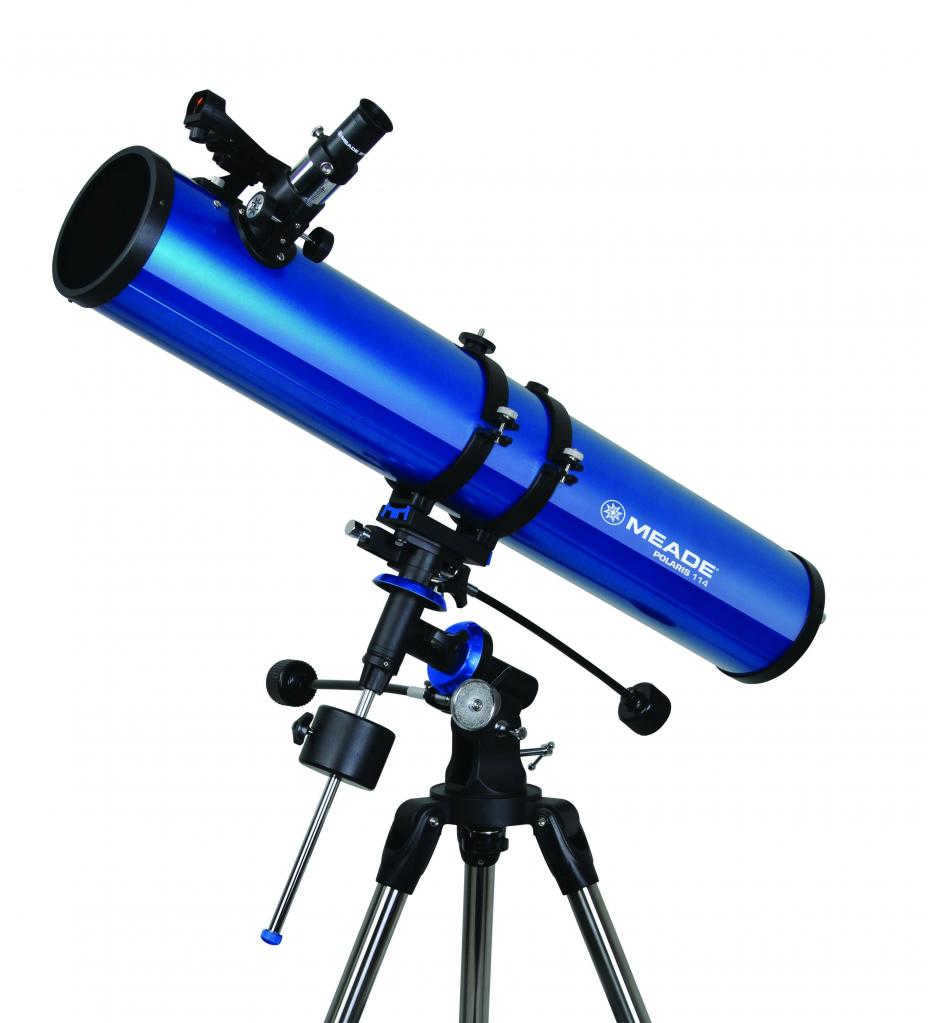
Image Quality
Reflecting telescope designs often incorporate a secondary mirror, film holder, or detector near the focal point of the primary mirror. While this setup helps focus light, it also partially obstructs the light reaching the primary mirror. As a result, the system collects less light and the image quality suffers from diffraction obstruction effects and diffraction spikes caused by secondary support structures.
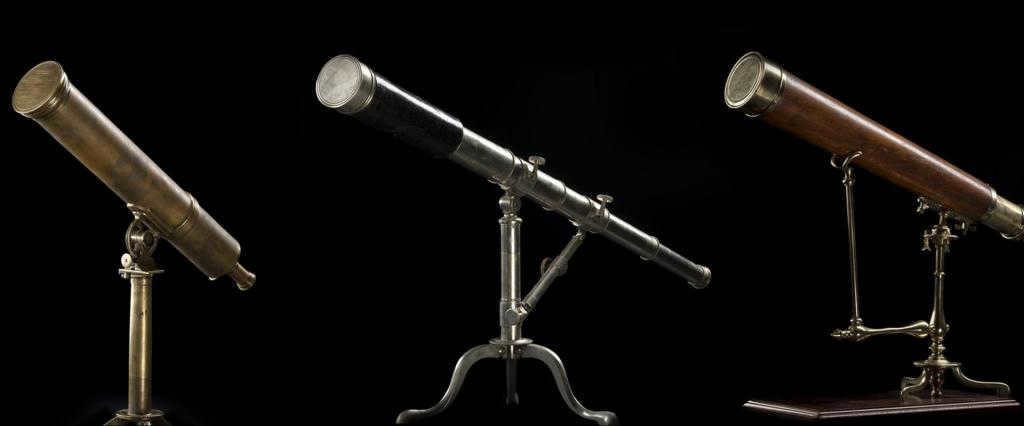
Using mirrors instead of lenses helps to eliminate chromatic aberration, although it introduces other types of aberrations. A basic spherical mirror cannot bring light from a distant object to a single focal point because the light rays reflecting off the edges of the mirror do not converge with those reflecting off the center, resulting in a flaw known as spherical aberration. To overcome this issue, modern reflector telescopes utilize parabolic mirrors, which are able to focus all the incoming light to a single focal point.
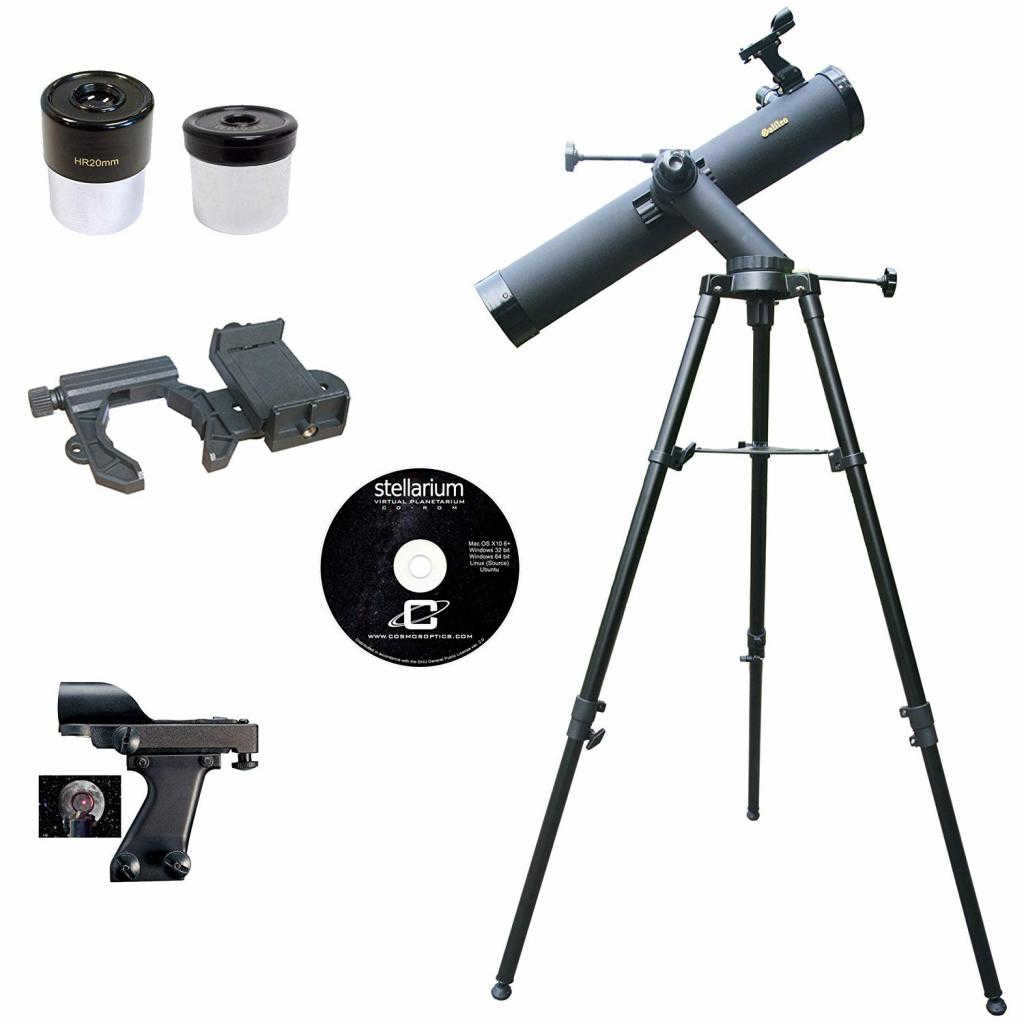
The Gregorian Telescope
In his 1663 book Optica Promota, James Gregory, a Scottish astronomer and mathematician, introduced the concept of the Gregorian telescope. This telescope utilizes a concave secondary mirror that reflects an image through a hole in the primary mirror. The result is a vertical image that is particularly useful for observations conducted from the ground. Numerous modern telescopes employ the Gregorian configuration.
Newton Reflector Telescope
The Newton Reflector Telescope, invented by Isaac Newton in 1668, was the first successful reflecting telescope. It typically features a paraboloidal primary mirror, although a spherical primary mirror can be used for focal ratios of f/8 or higher, which still provides excellent visual resolution. The light is reflected by the flat secondary mirror onto the focal plane situated at the top of the telescope tube. This design is popular among amateur astronomers due to its simplicity and affordability, especially for telescopes of this size. The principles of ray reflection in reflector telescopes were initially developed based on Newton’s innovative design.
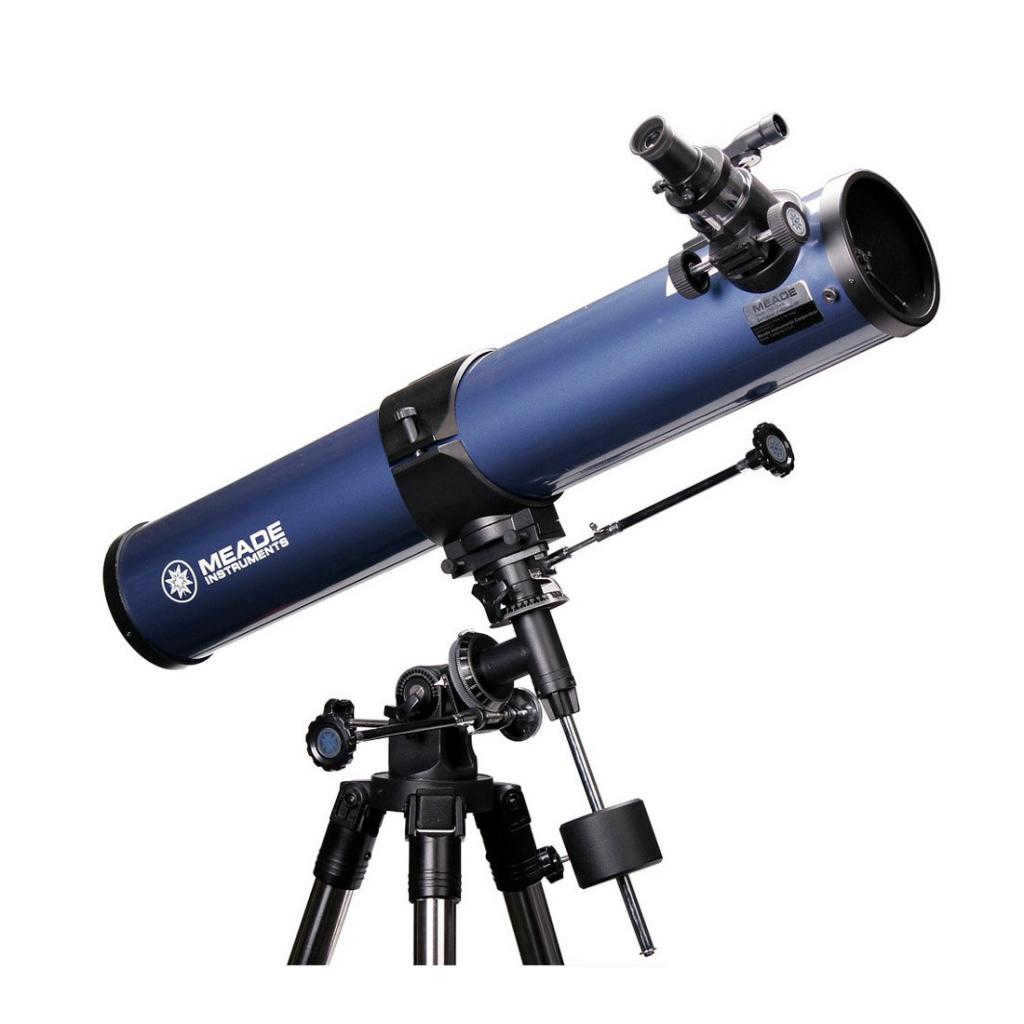
The Cassegrain Telescope
The Dall-Kirkham Cassegrain telescope design was invented by Horace Dall in 1928 and was named after a discussion between amateur astronomer Allan Kirkham and Albert G. Ingalls, the editor of Scientific American at the time. The design features a concave elliptical primary mirror and a convex secondary mirror. Although this design is easier to manufacture than the classic Cassegrain or Ritchey-Chrétien systems, it is not suitable for off-axis coma. The field curvature of the Dall-Kirkham design is actually less pronounced compared to the classic Cassegrain. Nowadays, this design is widely used in various applications of these incredible devices. However, it is gradually being replaced by its electronic counterparts. Nevertheless, the Dall-Kirkham Cassegrain design still remains the largest reflector telescope of its kind.
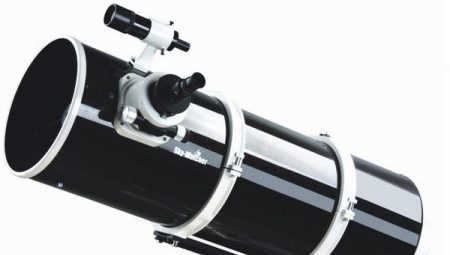
A reflector telescope is an optical device that utilizes the principle of reflection. In contrast to a lens, it employs a concave mirror as its objective lens, which reflects and focuses light rays onto the eyepiece for observation or photography. Let us explore the key distinguishing features of a reflector telescope.
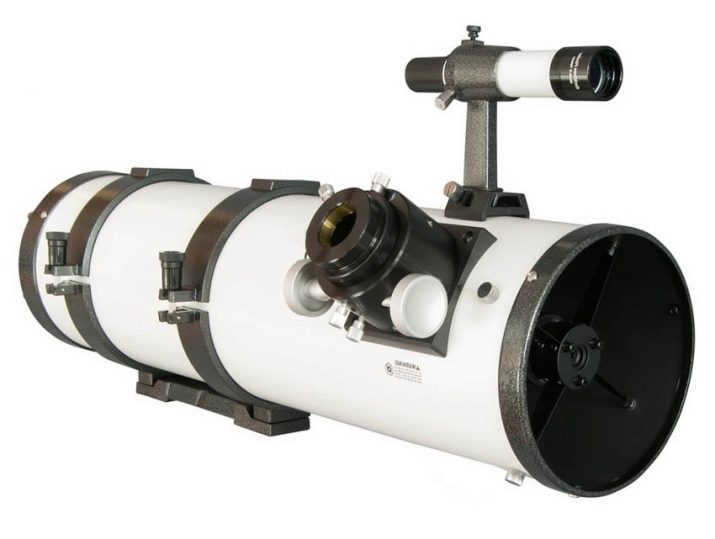
What is it?
Distinguishing a reflector telescope from a refractor telescope is quite straightforward, even for those without experience in astronomy. The design of the latter is rather simple. It consists of a tube, with its diameter depending on the diameter of the objective lens, which is positioned at the end facing the observed object. At the opposite end of the tube, there is an eyepiece – a lens with a smaller diameter, used for observation. The length of the tube in such an instrument is determined by the focal length of the lens and the strength of the material it is made from.
This, perhaps, is the main limitation of refractors, which restricts their potential. It is impossible to create a high-power instrument due to the significant weight of the structure.
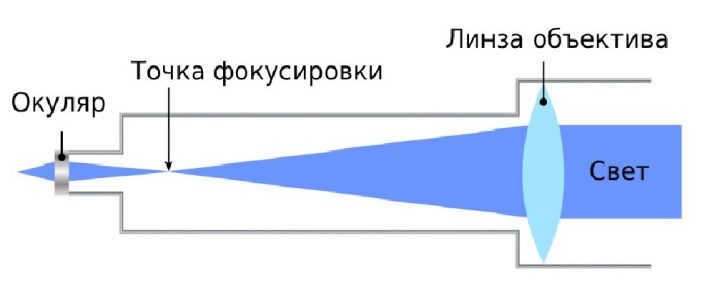
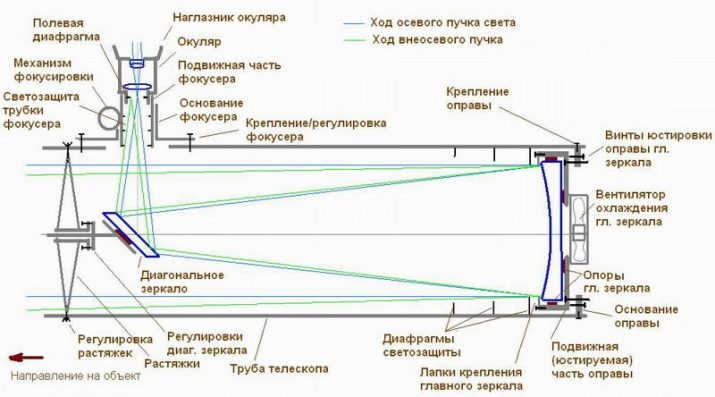
The optical properties of the mirror telescope, as well as its lenticular counterpart, are determined by the abilities of the lens. In the case of the concave mirror, the lens is used, while in the case of the lenticular counterpart, a different lens is employed.
Both types of telescopes, refractors and reflectors, are used successfully by amateur astronomers, each with its own advantages and disadvantages. Refractors rely on the refraction of light passing through the lens, while reflectors rely on the reflection of light from the curved surface. When it comes to portability and mobility, refractors are the better choice as they have a sturdier construction. Transporting reflectors is not recommended, as it can cause the elements of the structure to shift from their centerline, requiring realignment using screws. However, reflectors are suitable for use in amateur observatories.
The age of telescopic astronomy in scientific research. The primary objectives of the telescope. Exploring the chromatic aberration phenomenon. Evolutionary shifts in the nature of astronomical science. The reflector as the fundamental tool of astrophysics. Techniques for conducting radio interferometric observations.
Sharing your valuable contributions with the knowledge base is simple. Just fill out the form below.
Students, graduate students, and young scientists who utilize the knowledge base for their studies and work will greatly appreciate your contribution.
After Galileo first pointed a telescope into the sky in 1609, the possibilities for observing the stars and planets increased significantly. This marked the beginning of a new era in the field of science known as telescopic astronomy. Although Galileo’s telescope would be considered primitive by today’s standards, it was viewed as a miraculous invention by his contemporaries. Through the telescope, people could see that the Moon is a complex world similar to Earth, and that Jupiter has four small satellites orbiting it, just as the Moon orbits the Earth. These discoveries sparked new thoughts and discussions about the complexity of the universe, the existence of other inhabited worlds, and the materiality of the cosmos. The invention of the telescope, combined with the Copernican system, played a crucial role in challenging the religious beliefs of the Middle Ages.
The invention of the telescope, much like other significant discoveries, was not a result of chance, but rather a culmination of advancements in science and technology. In the 16th century, skilled craftsmen had already honed their abilities in creating lenses for eyeglasses, paving the way for the development of the telescope and microscope.
The telescope serves three primary functions:
1) It gathers radiation emitted by celestial bodies and directs it onto a receiving device such as the human eye, a photographic plate, or a spectrograph.
2) It forms an image of an object or a specific area of the sky in its focal plane.
3) It aids in the differentiation of objects that are closely positioned angularly, making them appear as a single entity to the naked eye.
The primary optical component of a telescope is the lens, which gathers light and forms an image of an object or a portion of the sky. The lens is connected to the receiver through a tube. The mechanical structure that supports the tube and allows it to be pointed towards the sky is referred to as the mount. When conducting visual observations, the eye serves as the receiver of light, and an eyepiece is necessary to view the image formed by the lens. However, for photographic, photoelectric, and spectral observations, an eyepiece is not required.
In the telescope’s focal plane, various components such as a photographic plate, the entrance aperture of an electrophotometer, or the slit of a spectrograph can be directly mounted.
A refractor, also known as a refracting telescope, is a telescope that uses a lenticular lens. Due to the fact that light rays of various wavelengths are refracted differently, a single lens produces a colored image. This phenomenon is known as chromatic aberration. However, chromatic aberration can be significantly reduced in lenses consisting of two different refractive index glasses (known as an achromatic lens or achromat).
The laws of reflection are not dependent on wavelength, leading to the idea of replacing the lens objective with a concave spherical mirror. This type of telescope is called a reflector, or a reflecting telescope. Sir Isaac Newton constructed the first reflector in 1671, which was only 3 cm in diameter and 15 cm in length.
A parallel beam of rays is not focused into a point by a spherical mirror; instead, it creates a slightly blurry spot at the focal point. This blurriness is known as spherical aberration. However, if the mirror is shaped like a rotating paraboloid, the spherical aberration disappears. A parallel beam directed along the axis of such a paraboloid is focused at the focal point with minimal distortion, except for some inevitable blurring caused by diffraction. As a result, modern reflectors typically use mirrors that have a paraboloidal shape, or more commonly known as a parabolic shape.
Until the late 1800s, telescopes were primarily used to observe and study the positions of celestial bodies. Comets and planetary disks were also of interest to astronomers. These observations were done visually, and the refractor telescope, equipped with a two-lens objective, was sufficient for their needs.
However, in the late 19th century and especially in the 20th century, the field of astronomical science underwent significant changes. The focus of research shifted towards astrophysics and stellar astronomy. Scientists began studying the physical properties of the Sun, planets, stars, and stellar systems. New tools, such as photographic plates and photocells, were developed for detecting and recording radiation. Spectroscopy also became a widely used technique. As a result, the requirements for telescopes evolved to meet these new demands.
When conducting astrophysical research, it is important to have a telescope with optics that do not restrict the range of wavelengths available. The Earth’s atmosphere already imposes limitations, so it is undesirable for the telescope’s optics to add further constraints. However, the lenses used in telescopes are typically made of glass, which absorbs ultraviolet and infrared radiation.
Photographic emulsions and cells are more sensitive to a wider range of the spectrum compared to the human eye. Consequently, chromatic aberration has a stronger impact when using these receivers.
Consequently, astrophysical research necessitates the utilization of a reflector. Furthermore, the production of a sizable reflector mirror is significantly less complicated compared to a two-lens achromat: only one surface needs to be precisely machined (to a precision of 1/8 of the light wavelength l, or 0.07 micron for visual rays), and there are no specific demands regarding the uniformity of the glass. As a result of these factors, the reflector has become a prominent instrument in the field of astrophysics. Refractors, on the other hand, are still employed in astrometric tasks.
The rationale behind this decision is the high susceptibility of reflectors to minor, random rotations of the mirror. Due to the equal angles of incidence and reflection, a rotation of the mirror by angle b results in an image shift of angle 2b. On the other hand, a similar rotation of the lens in a refractor leads to a much smaller shift. Considering the need for precise measurement of celestial object positions in astrometry, refractors were chosen as the preferred option.
As previously stated, a parabolic mirror reflector produces a highly clear image, but there is an important caveat to consider. The image can be considered flawless as long as it remains near the optical axis. As it moves away from the axis, distortions known as off-axis aberrations become apparent. Therefore, a reflector with just one parabolic mirror is not suitable for capturing large portions of the sky, such as a 5° field of view, which is necessary for studying star clusters, galaxies, and galactic nebulae. To address this limitation, combined mirror-lens telescopes were developed for observations requiring a wider field of view. In these telescopes, a thin lens, often made of uviolet glass that can transmit ultraviolet rays, corrects the aberrations caused by the mirror.
Historically, reflector mirrors (XVIII – XIX centuries) were crafted from a unique alloy of metal. However, due to technological advancements, opticians eventually transitioned to using glass mirrors. After undergoing optical processing, these mirrors are then coated with a thin layer of metal, typically aluminum, to enhance their reflection coefficient.
When it comes to telescopes, the two main defining characteristics are the diameter (D) and the focal length (F) of the objective lens. A larger diameter allows the telescope to gather a greater amount of light flux (F):
When capturing faint extended objects like nebulae and comets, it is crucial to have a large relative aperture. However, off-axis aberrations increase quickly as the relative aperture increases. The larger the relative aperture, the more challenging it becomes to eliminate these aberrations. As a result, the relative aperture of reflectors typically does not exceed 1:3. Mirror-lens systems and compound lenses can sometimes achieve a relative aperture of 1:1 or higher.
For a visual telescope, magnification is an important characteristic, which is determined by the ratio of the objective and eyepiece’s focal lengths.
If the human eye can distinguish two stars with an angular distance of at least 2', the telescope reduces this limit by a factor of n (however, it is important to note that this improvement is not unlimited).
The focal plane image scale is an important aspect in photography, as it determines the angular units per 1 mm. To calculate the image scale, the linear distance l between two points on the image with a mutual angular distance a needs to be known.
For instance, the approximate angular diameter of the Sun and Moon is 0.5°. When the focal length of the telescope is F = 1000 mm, the diameter of the image of the Sun and Moon in its focal plane is around 10 mm. Therefore, a reflector telescope that is designed for observations directly at the focus of a parabolic mirror is known as a direct-focus reflector. More intricate reflector systems are frequently utilized. For instance, an extra flat mirror that is mounted in front of the focus can be utilized to bring the focus laterally outside the tube (Newtonian focus). An additional convex pre-focal mirror can be used to extend the focal length and bring the focus out into a hole that is drilled in the center of the main mirror (Cassegrain focus), and so on.
These systems are more convenient for attaching receiving devices to the telescope, but they result in significant light losses due to the additional reflections.
Pointing the telescope at an object and tracking it is a challenging technical task. Modern observatories are equipped with telescopes of various sizes, ranging from a few tens of centimeters to several meters in diameter. The largest reflector in the world is currently in operation in the Soviet Union, with a diameter of 6 meters. It is located at an altitude of 2070 meters on Pastukhova Mountain, near the village of Zelenchukskaya in the North Caucasus.
The second largest reflector, with a diameter of 5 meters, is located in the USA at the Mount Palomar Observatory. The telescope mount always consists of two perpendicular axes, allowing for rotation and pointing at any part of the sky. This type of mount, known as a vertical-azimuthal mount, has one axis pointing towards the zenith and the other lying in the horizontal plane. It is commonly used for small portable telescopes.
Equatorial mounts are commonly used for large telescopes. These mounts have two axes – a polar axis that points to the pole of the Earth and a declination axis that lies in the plane of the celestial equator. When a telescope is mounted on an equatorial mount, it is referred to as an equatorial telescope.
In order to track celestial objects using an equatorial mount, it is only necessary to rotate the telescope around the polar axis in the direction of the rising hour angle. This is because the declination of the celestial object remains constant. This rotation is automatically done by a clockwork mechanism.
There are various varieties of equatorial mounts that exist. Telescopes with a moderate diameter (up to 50 – 100 cm) are frequently affixed to a German mount, wherein the polar axis and the declination axis come together to form a parallactic head that rests upon a column. On the declination axis, on one side of the column, the tube is positioned, while on the other side, a counterweight is used to balance its weight.
The English mount differs from the German mount in that it utilizes two columns, one at the north and one at the south, to support the polar axis, providing it with added stability. In some variations of the English mount, the polar axis is replaced by a four-cornered frame, which encloses the telescope tube. However, this design restricts the telescope’s ability to point towards the polar region of the sky. To overcome this limitation, the north (upper) bearing of the polar axis can be shaped like a horseshoe. Alternatively, the north column and bearing can be completely eliminated, resulting in an American mount or fork.
The clockwork mechanism may not always be perfectly accurate, so when taking long-exposure photographs that can last for many hours, it is important to regularly check and adjust the telescope’s pointing. This process is known as guiding. Guiding is done using a small auxiliary telescope called a guide, which is mounted on the same mount as the main telescope. Thanks to electronic computing machines, it is now possible to accurately track celestial objects using a vertical-azimuth mount by smoothly rotating around both axes. The Soviet six-meter reflector was the world’s first large optical telescope to use a vertical-azimuth mount.
When it comes to studying the Sun, having a high image scale is crucial. This means having a large focal length, which is why telescopes used for studying the Sun are typically fixed in place. To direct light into the telescope’s optical system, a special setup called a celostat is used. The celostat consists of two flat mirrors that reflect a beam of light rays from the Sun in a consistent direction, regardless of the daily rotation of the sky.
As the celestial body itself moves at the same velocity, the rotation is compensated for and the beam is reflected in the identical direction.
There are two primary types of large solar telescopes: vertical, or tower, and horizontal. In a tower telescope, the celestial body directs the beam vertically downward, and the optical system that constructs the image of the Sun is positioned vertically.
Spectral and other analyzing equipment is situated in a laboratory room at the tower’s base. In a horizontal telescope, the celestial body emits a beam in the horizontal direction, with all the optical components of the system arranged accordingly. The horizontal telescope is structurally more convenient. However, atmospheric disturbances in the surface layer have a stronger impact on the image quality of a horizontal telescope compared to a tower telescope.
The corona, the outermost and most rarified part of the solar atmosphere, has traditionally only been observed during rare occurrences of total solar eclipses. The corona’s brightness is 106 times lower than that of the solar disk. Under normal circumstances, the scattering of sunlight in the Earth’s atmosphere and through telescopes creates a halo around the Sun, making it impossible to distinguish the corona. However, during a total solar eclipse, the Moon covers the solar disk, revealing the pearly glow of the corona against the darkened sky.
Over the years, numerous astronomers and opticians have attempted to develop special telescopes that can capture images of the corona outside of an eclipse. One of the first successful attempts was made by the renowned French astrophysicist Lio, who utilized a refractor with a single-lens objective.
This system guarantees a minimal amount of scattered light in the telescope. In order to minimize the effects of atmospheric scattering, Lio decided to install his instrument (which he referred to as an extra-sun coronograph) on top of a mountain. Additionally, he placed an artificial moon inside the telescope, effectively blocking the image of the solar disk from the observer. By taking these precautions, it became possible to visually observe and photograph the solar corona in the presence of its brightest emission lines.
In the present day, coronographs based on this same principle can be found in numerous countries, and observations of the corona have become a regular part of the Solar Service’s program. Unlike general-purpose solar telescopes, the eclipse coronograph is mounted on a conventional equatorial mount, as using a full-stage mirror would result in an excessive amount of scattered light.
One may naturally inquire: What factors determine the quality of the images produced by a telescope? Initially, it may appear that increasing the magnification (or, in the case of a photographic telescope, the scale) would allow for greater detail to be observed in planetary disks and enable closer examination of double star pairs. However, this assumption is incorrect.
Jitter is a result of the atmosphere’s optical inhomogeneity and turbulence. Tiny masses of air move independently, causing fluctuating pressure and unequal refractive index along the path of the light beam. As the beam passes through the atmosphere, it gets refracted and deflected, with the magnitude and direction of deflection changing over time.
The atmosphere contains small irregularities that are around 10 cm in size. Therefore, if the telescope’s diameter is significantly larger than 10 cm, the image of a star will appear blurred. If the telescope’s diameter is smaller, the entire image will fluctuate. This blurring of a star’s image due to atmospheric wobble is known as a wobble disk. The size of the wobble disk depends on local natural conditions, as well as the size and design of the telescope and observatory.
Currently, scientists are conducting research on space radio emissions across a range of wavelengths, from one millimeter to several tens of meters. The radio telescopes used to receive these signals are equipped with antennas that are typically parabolic reflectors, similar to the mirrors found in traditional astronomical telescopes. These antennas are designed to collect and focus the radio radiation onto an irradiator, a device located at the focal point of the paraboloid.
The irradiator then transmits the collected energy to the receiver input. Once received, the signal undergoes amplification and detection before being recorded onto the tape of a self-recording electrical measuring instrument.
Radio telescopes do not need to be as precisely fabricated as optical telescopes because they do not require the same level of distortion-free performance. In order to avoid distortion, the mirror of a radio telescope should deviate from a parabolic shape by no more than l/8, where l is the wavelength. Fortunately, radio wavelengths are much larger than optical wavelengths. For example, a mirror accuracy of about 1 cm is sufficient for a wavelength of 10 cm in the radio range.
Additionally, radio telescope mirrors can be made non-continuous by stretching a metal grid on a frame and giving it an approximate paraboloidal shape. Furthermore, radio telescopes can be made stationary by replacing the rotation of the mirror with a displacement of the irradiator (up to 10 – 20°). These unique features contribute to the larger size of radio telescopes compared to optical telescopes.
The Arecibo Observatory in Puerto Rico is home to the world’s largest full-profile radio astronomy antenna, with a diameter of 300 meters. This impressive antenna is situated in a natural depression, which was formed by an extinct volcano and shaped into a paraboloid. Concrete was used to secure the shape, and the entire structure is coated with metal.
While the antenna is fixed and pointed towards the zenith, it still allows for the reception of radio emissions from a considerable portion of the celestial sphere. This is made possible by the Earth’s daily rotation and the antenna’s ability to be adjusted. As a result, astronomers have access to a wide range of sky for observation and study.
Smaller radio astronomical mirrors are typically installed on either a vertical-azimuth mount or an equatorial mount. The largest antenna of this kind, with a diameter of 100 m, is located in Bonn, Germany. However, these massive antennas are not capable of operating at millimeter wavelengths due to their lack of precision. Maintaining a parabolic shape with an accuracy of a few tenths of a millimeter is an extremely challenging task for antennas with diameters of several tens of meters.
When it comes to high-precision instruments suitable for working with the shortest wavelengths, two Soviet 22-meter radio telescopes stand out. One of these telescopes is located at the Lebedev Physical Institute, while the other is situated at the Crimean Astrophysical Observatory.
When wavelengths reach several meters or more, parabolic antennas are not utilized. Instead, systems are employed that consist of numerous dipole antennas, which are electrically coupled to provide the necessary directional reception for a radio telescope.
In order to describe the angular resolving power of a radio telescope, a specific characteristic known as the directivity diagram is utilized. This diagram shows the dependence of a radio telescope’s sensitivity on the position of a point source of radio radiation in relation to the antenna. A radio telescope with a symmetrical parabolic antenna exhibits a radiation pattern that is symmetrical about its axis.
The angular resolution of a radio telescope is determined by the width of its “half-power” radiation pattern, which represents the minimum angle between two separate sources. Diffraction, similar to optical telescopes, imposes a physical limitation on the theoretical angular resolution.
Due to the long wavelengths in the radio range, radio astronomical mirrors, despite their large size, have a significantly lower angular resolution compared to optical mirrors. For example, the 300-meter Arecibo antenna operating at a wavelength of 70 cm has an angular resolution several hundred times worse than the average practical limit of an optical telescope (1-2″). However, it is possible to achieve equal resolving power for both telescopes by using a radio interferometer.
The most basic form of a radio interferometer consists of two antennas spaced a certain distance apart, known as the baseline. Both antennas emit signals through wires to a common receiver.
Recently, a method of radio interferometric observations has been developed using two independent receivers. In this scenario, the antennas of the interferometer can be thousands of kilometers apart. These systems have allowed for significant advancements in radio astronomy, achieving an angular resolution on the order of 10 – 4 seconds of arc, surpassing the capabilities of optical telescopes.
Thanks to the advanced development of radio astronomy techniques, extensive research has been conducted on the radio emissions of celestial bodies such as the Sun, the Moon, the planets from Mercury to Uranus, various objects within our own galaxy (such as supernova remnants, pulsars, nebulae, and interstellar gas clouds), as well as radio emissions from extragalactic objects.
These radio astronomical observations have led to the discovery of a new type of extragalactic objects known as quasars. Furthermore, the study of radio emissions has yielded significant findings in various fields of astrophysics.
Conventional optical telescopes are employed in the infrared range (with wavelengths ranging from 1 micron to 1 millimeter). The main challenge in this range is the interference caused by the telescope’s thermal radiation and the atmosphere. Moreover, the atmosphere strongly absorbs radiation across most of the infrared range.
Nonetheless, there are certain portions of the spectrum where the transmittance is sufficiently high.
The observation of X-rays (with wavelengths ranging from 0.1 to 10 angstroms) presents particular difficulties. Modern grinding and polishing methods do not allow for the production of mirrors with such precision. However, it has been discovered that when the beam is incident and reflected at an angle close to 90 degrees from the normal, the requirements for mirror surface accuracy are significantly reduced.
Telescopes that utilize this principle are referred to as oblique incidence telescopes and, when positioned on man-made satellites, enable the detection of X-ray radiation from celestial sources.
In the X-ray and gamma-ray ranges, tube collimators, which consist of sets of parallel tubes with sufficiently thick walls placed in front of a high-energy photon detector, are also employed to restrict the viewing angles to narrower or wider ranges.
For wavelengths shorter than 10 – 4 (quantum energy greater than 100 Mev), the angular resolution is achieved through the specific method of detection: these quanta, upon interacting with matter, produce pairs of electrons and positrons that move in almost the same direction as the original quantum itself.
Documents of this kind
The dawn of the era of telescope astronomy. The Galileo telescope’s inability to move at high speeds. The primary objective and design of the telescope. Characteristics of the reflector with a parabolic mirror. Fundamental features of the telescope: diameter and focal length. Mounting of the telescope.
The subject matter and objectives of astronomy. Unique aspects of astronomical observations. The operational principle of the telescope. The visible daily motion of stars. Definition and types of constellations. The ecliptic and “wandering” celestial bodies-planets. Star charts, celestial coordinates, and time.
Astrophysics aims to investigate the physical nature and evolution of individual celestial objects. Optical telescopes and their applications. The history of initial observations. The design and construction of telescopes. Ground-based spectral studies. Contemporary astronomy.
The topic of astronomy is a fascinating subject that has been studied for centuries. There are various sources of knowledge in astronomy, including telescopes, constellations, star maps, and celestial coordinates. Working with these tools, astronomers are able to determine the coordinates of celestial bodies and track their movements. One important aspect of astronomy is the culmination of the luminaries, which is the highest point they reach in the sky. Another significant concept is the theorem on the height of the pole of the world, which helps astronomers measure time and make calculations.
Astronomy is an ancient field of study, with its origins dating back thousands of years. In ancient China, astronomers studied the visible movements of the Sun and the Moon as early as 2,000 BC. Ptolemy’s world system was a significant development in astronomy, and it laid the foundation for the science of astrophysics. In modern times, astronomy has achieved remarkable advancements, thanks to technological innovations and scientific discoveries.
One of the key inventions in astronomy was the telescope, which was first created by Galileo. Other astronomers, such as Hevelius, Huygens, Kepler, and the Paris Observatory, also contributed to the design and improvement of telescopes. Newton-Herschel reflectors and single-lens long refractors were important stages in the development of telescopes. Achromatic telescopes, which were developed in later generations, further enhanced the capabilities of astronomers. Today, we have third and fourth generation reflectors that continue to push the boundaries of astronomical research.

The telescope is an optical device that enables the observation of distant objects. Its unique design allows for the collection of electromagnetic radiation, resulting in the magnification of celestial bodies.
Historical Context
The exact origin of the telescope and its inventor remain uncertain, but it is widely believed to have been created by Dutch eyeglass maker John Lippersguy.

The first person to showcase an instrument resembling a modern telescope was John Lippersguy in 1607 at The Hague, fulfilling the long-awaited desire of sailors. However, he was unable to obtain a patent because Zacharias Jansen from Middelburg and Jacob Metius from Alkmaar already possessed similar devices.
Even before this significant invention, Leonardo da Vinci had created initial sketches in 1509. These sketches depicted simple telescope-like instruments with one or two lenses.
Development of the initial refractor telescope
In 1609, the renowned scientist Galileo Galilei created a groundbreaking device designed for observing celestial objects. Galileo’s first telescope provided a threefold increase in magnification, followed by an 8-fold increase in the second model, and a 32-fold increase in the third. Despite the limitations of these early telescopes, Galileo Galilei made numerous significant discoveries pertaining to the universe. Notably, he was the first to observe:
- The lunar mountains and craters;
- The stars comprising the Milky Way;
- Sunspots;
- The four moons orbiting Jupiter;
- The rings encircling Saturn.
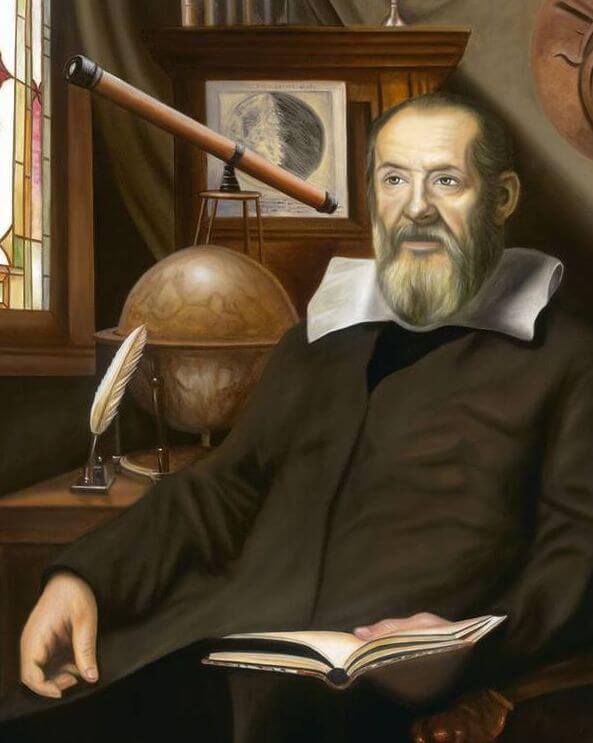
The current optical instrument did not receive its designation right away. In 1611, Ioannis Dimisianos, a renowned mathematician from Greece, proposed that this device be referred to as a telescope.
This marked the commencement of the refractor’s era in the field of astronomy, which was first discovered by Galileo Galilei.
The telescope was constantly striving for improvement, but it proved impossible to manufacture large-sized lenses, resulting in long, unwieldy instruments with a limited field of view. Consequently, tripods were the only viable solution during that time.
In the latter half of the 17th century, Christian Huyens designed a telescope measuring 7 meters in length, capable of magnifying objects 100 times, with an aperture of approximately 15 cm. Nowadays, a similar device is considered amateur-grade and recommended for novice astronomers. Multiple attempts were made to enhance the telescope’s capabilities. By the end of the 17th century, a telescope measuring 70 meters in length had been constructed! However, operating and adjusting such a massive instrument proved challenging. Even the slightest gust of wind posed a significant obstacle to observations. Brilliant minds exerted tremendous efforts to refine its functionality.
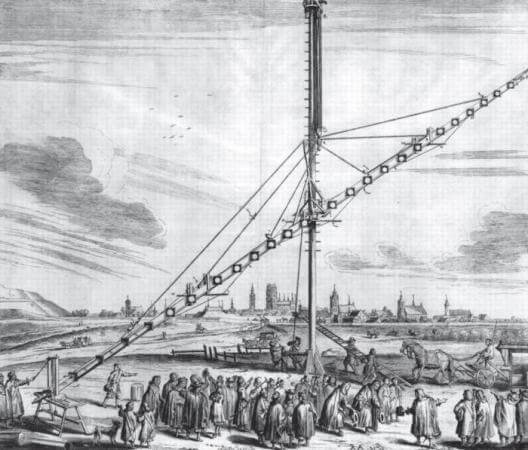
An entirely novel creation was credited to Isaac Newton. His invention allowed for the collection and focusing of rays using a concave mirror. Consequently, Galileo’s refractor was transformed into Newton’s reflector. The primary challenge lay in producing a high-quality mirror for the device. Newton utilized an alloy of copper, tin, and arsenic, which greatly enhanced the image and achieved a 40-fold magnification. The king was so impressed with the telescope that Newton was immediately made a member of the Royal Society. This occurred in 1704, marking the advent of Newton’s reflector in the 18th century. His homemade telescope can still be found in the London Museum of Astronomy.
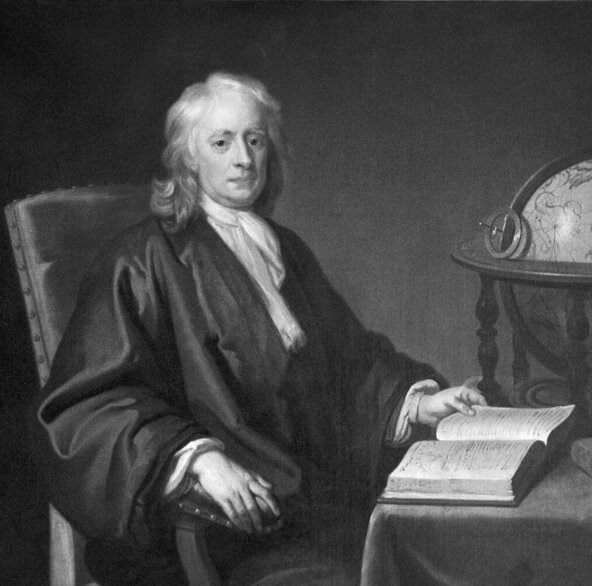
The telescopes became more practical and portable, with a reduced length of no more than 2 meters. However, they still remained somewhat cumbersome. Nevertheless, they could be easily transported and taken along on journeys.
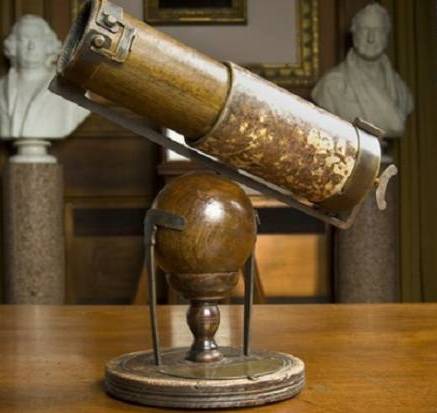
Evolution of Refractor and Reflector Telescopes
In the late 18th century, a revolutionary development in telescopes emerged. A French astronomer named Cassegrain proposed a new design that utilized two mirrors instead of one. However, due to the technological limitations of the time, his concept couldn’t be realized. It wasn’t until the modern era that his invention became a reality with the creation of the powerful Hubble telescope. The Hubble telescope incorporates mirrors that operate based on the principle initially described by Cassegrain.
However, reflectors were not forgotten by amateur astronomers. One notable example is the English musician William Herschel, who constructed his own reflector telescope and, in 1781, made a remarkable discovery – a new planet in space, Uranus, surprising the scientific community. This achievement spurred Herschel to further improve the telescope, resulting in the creation of the largest reflector of that time, boasting a mirror diameter of 122 cm. As a result, two additional satellites of Saturn were also discovered.
Following in Herschel’s footsteps, the English Lord Ross built a reflector with an even larger mirror diameter of 182 centimeters. This telescope immediately unveiled previously unknown spiral nebulae. However, even these telescopes had their drawbacks – they were heavy, had limited light reflection, and their mirrors quickly deteriorated.
It was not until the year 1856. that physicist Léon Foucault made use of a mirror that was crafted from silvered glass. This experiment turned out to be a success.
Russian scientists also did not lag behind; they played a role in the development of new inventions. J.V. Bruce invented metal mirrors, while M.V. Lomonosov (along with Herschel) worked on a new design that aimed to minimize light loss.
Only in the late 19th century did lenses with a glass surface treated with silver start to be manufactured. These lenses were able to reflect up to 95% of the light flux, which was a significant breakthrough in telescope construction.
L. Foucault constructed a reflector by utilizing a parabolic mirror, which at that time was an enormous 91 cm.
Telescopes with large mirrors became increasingly common during the twentieth century. For instance, the Mount Wilson Observatory houses a device with a 256 cm diameter mirror, while California is home to a giant reflector twice the size.
The Telescopes of the Twentieth Century
Thanks to the discoveries and advancements of previous centuries, as well as the developments of the twentieth century, telescopes have reached a whole new level. They now provide high-quality images and precise information about celestial objects, all with the assistance of computerized guidance. Here are a few notable examples:
- In 1976, Soviet scientists successfully installed a telescope in the North Caucasus region, known as BTA – Bolshoi Telescope Azimutal. This impressive instrument boasts a massive six-meter mirror, weighing 42 tons. The BTA played a crucial role in making significant discoveries regarding the interaction and evolution of galaxies. During that era, it stood as the sole giant telescope of its kind.
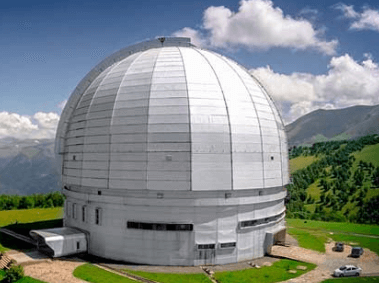
- The Hubble Space Telescope is a space-based observatory equipped with all the necessary instruments for astronomy observations and research. Due to its location outside Earth’s atmosphere, the images captured by the telescope in space are of exceptional quality. Launched in 1990, it is slated to be replaced after 2020.
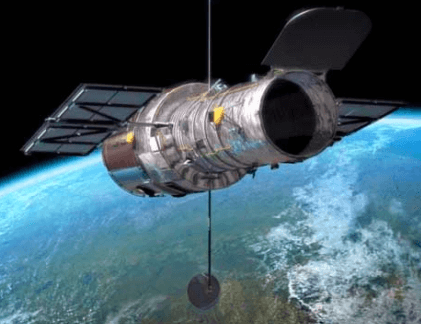
- Between 1993 and 1996, two highly efficient twin telescopes, KECK 1 and KECK 2, were installed on the Manua Kea mountain, an extinct volcano. These telescopes, which are as large as an 8-story house, have enabled scientists to discover and explore exoplanets thanks to their high-precision angular resolutions.
Advancements in Modern Telescopes
Modern telescopes have seen significant advancements in mirror size, manufacturing precision, and the range of wavelengths they can observe. Observatories now operate in various bands, including infrared, ultraviolet, X-rays, terahertz, and more. These telescopes are equipped with sophisticated computer programs that enable the accumulation and analysis of data.
- The Large Canary Reflector Telescope was installed in 2007 on the Muchachos volcano at an altitude of 2,400 meters. This state-of-the-art telescope allows for the study of the most distant objects in outer space.
- In the Chilean Atacama Desert, situated at an altitude of 5,100 meters above sea level and known for its extremely dry air, the CONDOR detector has been in operation since 2005. It plays a crucial role in studying the Universe within the terahertz range.

These telescopes have revolutionized the exploration of outer space, providing unprecedented access to the farthest corners of the Universe and unlocking the secrets of distant celestial bodies such as stars, planets, and galaxies.
Regardless of the immense size of contemporary telescopes, enthusiasts of astronomy will always be intrigued by the prospect of owning their own personal device. That’s why we invite you to browse through the pages of our website and discover the perfect telescope for yourself or as a thoughtful gift for someone special!
Imagine visualizing a human eye with a diameter of 5 cm. Concurrently, envision it extended halfway across a meter from the pupil to the retina. This is essentially how a telescope operates, akin to a colossal eyeball. In essence, our eye functions as a large lens. It does not directly perceive the objects themselves, but rather captures the light that is reflected off them (which explains why we are unable to see anything in complete darkness). The light passes through the lens and reaches the retina, where impulses are subsequently transmitted to the brain, which then constructs an image. Comparatively, a telescope possesses a lens that is considerably larger than our own. As a result, it has the ability to gather light from distant objects that the human eye simply fails to detect.
Although the basic principle of operation remains consistent across all telescopes, their structures exhibit variability.
The initial kind of telescopes are refractors
A basic form of a refractor is a cylindrical device with double-convex lenses inserted into both ends, shaped like this ( ). These lenses gather light from celestial objects, refract and concentrate it, and we can observe the resulting image through the eyepiece.
Levenhuk Strike 80 NG refractor telescope:
Reflectors: The Second Type of Telescopes
Unlike refractors, reflectors do not rely on refraction but instead utilize reflection. The fundamental design of a reflector telescope consists of a tube containing two mirrors. The larger mirror is positioned at the opposite end of the tube from the lens, while the smaller mirror is located in the middle. When light enters the tube, it is reflected off the large mirror and directed towards the small mirror, which is angled to guide the light into the lens or eyepiece. By looking through the eyepiece, we are able to observe celestial objects.
One example of a reflector telescope is the Bresser Junior Reflector Telescope. It can be easily distinguished from a refractor telescope by the positioning of the eyepiece. In a refractor telescope, the eyepiece is located at the end of the tube, whereas in a reflector telescope, the eyepiece is situated on the side.
Let’s begin by examining the functionality of telescopes using refractors as an example. For this demonstration, we will focus on the Levenhuk Strike NG series telescopes, which are specifically designed for novice astronomers and feature a simplified construction.
Refractor telescopes utilize a lens to gather incoming light. This lens is typically made of glass, which explains why refractors are not commonly available in larger sizes due to the weight of the glass. However, an exception to this is the Yerkes Observatory in the United States, which houses the largest refractor telescope with a lens diameter of 1.02 meters.
Inside the telescope tube, you will notice that it is coated in black to minimize glare caused by bright objects.
Furthermore, there is a protective hood in place to safeguard the lens from dew and provide some defense against minor mechanical damage, such as shocks or bumps. Additionally, the hood serves to eliminate glare originating from flashlights and other nearby objects.
Lastly, we have the eyepiece, which allows us to observe the celestial sky.
The use of a diagonal mirror (with an eyepiece and a Barlow lens) is essential in order to obtain a straight image, rather than an inverted one. This allows for the observation of both celestial and terrestrial objects through the telescope, as shown in the accompanying image.
This particular image was captured with a digital camera attached to the telescope using an adapter.
It is important to note that not all refractor telescopes can accommodate a camera. For instance, the entry-level models such as the Levenhuk Strike NG, priced at 3,000 rubles, do not have this capability.
And now, the most exciting part – the stunning pictures that can be captured with the telescope:
This photograph was captured during the autumn season under clear weather conditions using a Levenhuk Strike 80 NG refractor telescope. While the Moon was successfully captured, it is challenging to photograph planets or galaxies with a refractor telescope. This particular model is designed for beginners in astronomy, allowing them to take their first steps in the field. However, it can still be used for observing and photographing objects on Earth.
If you would like to learn more about telescopes and their principle of operation, please visit this link. The image can be found at this location. The image is also available in a smaller size at this link. The photograph was taken on June 15, 2012 at 20:19:55 GMT+04:00 by Gennady.
Visualize a human eye that measures 5 cm in diameter. Simultaneously, envision it being elongated by half a meter from the pupil to the retina. This concept is analogous to the functioning of a telescope, which essentially operates as a magnified eye. In essence, our eye functions as a large lens. Although it does not directly perceive objects, it captures the light that is reflected from them (even in complete darkness).
Add a comment Cancel reply
The most recent news on the blog
Declining insect populations on Earth are a result of human activities
Limonene: Utilizing orange peel to tackle humanity’s significant issues
What causes our uneasiness with overly human-like artificial intelligence?
Why is sea ice made up of fresh water when the oceans have a high salt content?
Solar transportation – the current state of evolution
Incredible: the ability to transfer a person’s consciousness into a computer will soon become a reality!
Most popular
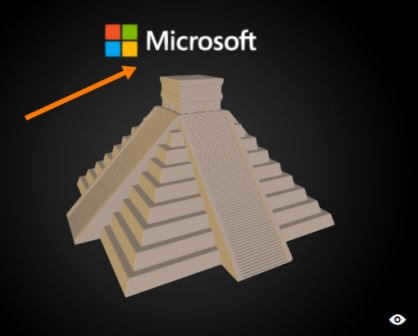 How to download a 3D file from sketchfab and view it 02.12.2015 Once, describing the principles of the site to which you can, like a site… (92)
How to download a 3D file from sketchfab and view it 02.12.2015 Once, describing the principles of the site to which you can, like a site… (92) All U.S. Presidents – photos and dates 29.08.2015 For the entire existence of the United States in this country "rule" 44… (53)
All U.S. Presidents – photos and dates 29.08.2015 For the entire existence of the United States in this country "rule" 44… (53) Ten innovative synthetic materials with extraordinary properties 14.09.2013 Despite the vast array of substances and minerals naturally occurring, humans have managed to create ten artificial materials with exceptional properties that are truly unique. (24)
Ten innovative synthetic materials with extraordinary properties 14.09.2013 Despite the vast array of substances and minerals naturally occurring, humans have managed to create ten artificial materials with exceptional properties that are truly unique. (24) Tips on deleting or modifying folders in Yandex-mail 25.07.2013 On the surface, it may seem like a straightforward question, but there are suspicions that the process of deleting or editing folders in Yandex-mail may not be as simple as initially thought. (19)
Tips on deleting or modifying folders in Yandex-mail 25.07.2013 On the surface, it may seem like a straightforward question, but there are suspicions that the process of deleting or editing folders in Yandex-mail may not be as simple as initially thought. (19)- Analyzing a person’s character through their handwriting: a comprehensive guide 26.08.2013 Determining an individual’s character and personality type by analyzing their handwriting can be a challenging task. However, with the right techniques and knowledge, it is possible to gain valuable insights into a person’s traits and disposition. (13)
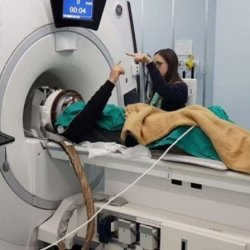 The Sleeping Brain Retains the Best Memories of the Previous Day 22.07.2021 During sleep, the brain efficiently organizes a vast amount of information that it has received throughout the day… (10)
The Sleeping Brain Retains the Best Memories of the Previous Day 22.07.2021 During sleep, the brain efficiently organizes a vast amount of information that it has received throughout the day… (10)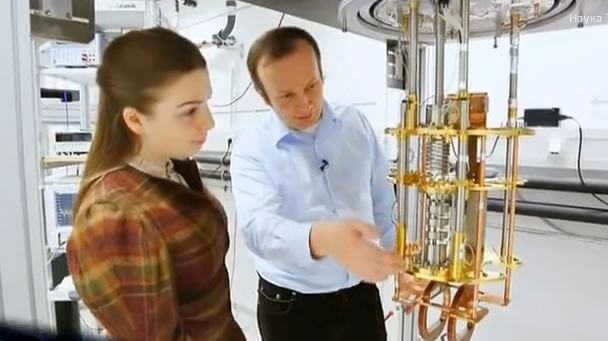 The Quantum Computer: Anticipated and Feared 08.12.2013 The quantum computer is not just a computer of the future, it is… (9)
The Quantum Computer: Anticipated and Feared 08.12.2013 The quantum computer is not just a computer of the future, it is… (9) Cognitive Science: A Fascinating Video 27.04.2016 What is the purpose of cognitive science? Psychologist Maria Falikman discusses the “cognitive polygon”… (9)
Cognitive Science: A Fascinating Video 27.04.2016 What is the purpose of cognitive science? Psychologist Maria Falikman discusses the “cognitive polygon”… (9) It can be quite useful to familiarize yourself with the hotkeys available in Windows and various software programs. These shortcuts are designed to save time and improve efficiency. (8)
It can be quite useful to familiarize yourself with the hotkeys available in Windows and various software programs. These shortcuts are designed to save time and improve efficiency. (8) If you need to register for an electronic pass in the ATO zone, you can follow these step-by-step instructions on the SBU website. This process will allow you to easily obtain the necessary documentation. (8)
If you need to register for an electronic pass in the ATO zone, you can follow these step-by-step instructions on the SBU website. This process will allow you to easily obtain the necessary documentation. (8)
If you have made the choice to purchase an amateur telescope, it is essential to understand how it functions in order to effectively plan your observations. In reality, the principle of operation and purpose of the telescope is not as complex as it may initially appear, and anyone, particularly those with a keen interest in astronomical instruments, can comprehend the fundamentals of optics.
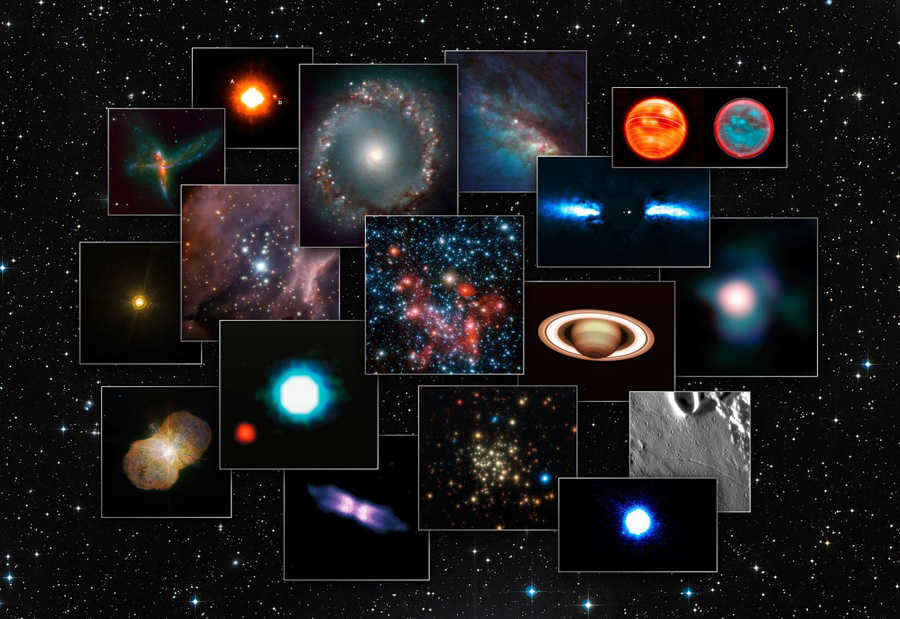
It is common knowledge that, in addition to simple optical models designed for astrometry and astrophysics, there are also radio telescopes, as well as models that operate under conditions of X-ray and infrared radiation. Interestingly, any radio telescope is completely distinct from its optical counterpart. However, despite these differences, the objectives of any instrument can be simplified to the following:
- To gather the maximum amount of light (or energy);
- To maximize the illumination of a celestial body;
- To create a high-quality image of the object;
- To increase the angular distance between the object and the observer.
The term “telescope magnification” simply refers to the increase in this angular distance, which is equal to the ratio of the focal lengths of both the objective lens and the eyepiece.
Therefore, the primary principle of telescope operation does not lie in magnification. When novice astronomers visit an optical goods store, they often inquire, “How much does this device magnify?” This question is clearly misguided because the key factor in producing a clear image is the size of the light-gathering element, which can be either a lens or a mirror depending on the specific model’s design. The amount of light that a telescope can collect directly determines the level of detail in the resulting image, be it the lunar landscape or the rings of Saturn.
Magnification certainly plays a role, but it is not as significant as the size of the entrance aperture or lens.
What is the design of an optical telescope?
Every optical telescope, regardless of its specific design, is equipped with an eyepiece and a lens. The objective, which directly faces the celestial body being observed, is the lens or mirror, while the smaller lens used for aiming is called the eyepiece. These two components are situated along the traditional optical axis.
How does a telescope operate in general? In order to observe objects that are close in proximity, it is necessary to periodically switch between different eyepieces. Typically, each telescope is provided with at least two different eyepieces. These eyepieces allow the observer to alter the magnification settings while utilizing the same lens.
A collecting lens, conventionally denoted with a “plus” sign, is a telescope lens that thickens towards the center. On the other hand, a scattering lens, represented by a “minus” sign, appears thinner in the middle. The optical axis is a straight line connecting the centers of these lenses. When parallel rays of light pass through the lens, they are refracted and converge at a focal point. A telescope lens with a pronounced curvature will result in a smaller focus, producing an image that closely resembles reality.
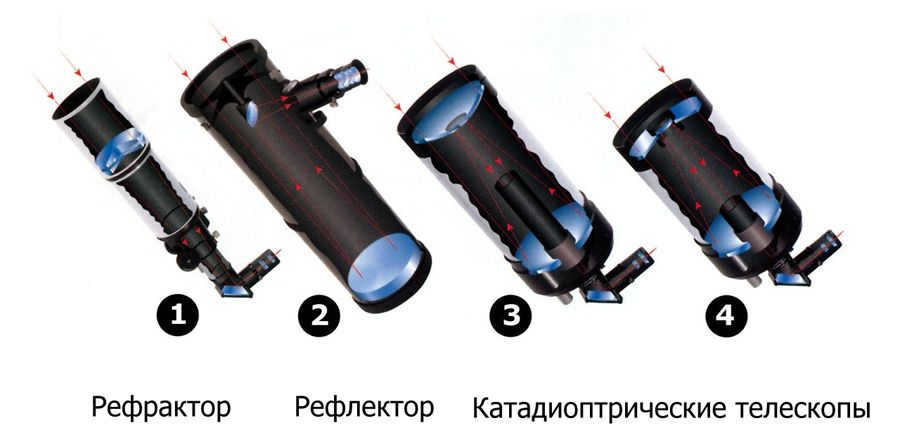
What is the functioning principle of a refractor telescope? It is commonly referred to as a refracting telescope due to its utilization of a sizable, thick lens to gather light. The majority of refractors employ a two-element lens configuration. This arrangement, known as achromatic, serves to eliminate or minimize the occurrence of false colors. These artifacts inevitably manifest during the observation process and can significantly degrade the quality and interpretation of the resulting imagery. This is why the notion of refractor-achromats has been introduced.
Nevertheless, if you create lenses that are excessively large and bulky, and subsequently mount them in a telescope, the absorption of light will be amplified, resulting in an instrument that is quite cumbersome to handle. Nonetheless, refractor telescopes continue to be highly regarded worldwide and maintain their significance in the realm of professional astronomy. As an illustration, the Pulkovo Observatory effectively operates a substantial refractor featuring a lens diameter of 65 cm, while the Yerkes Observatory boasts a telescope equipped with a one-meter lens.
Reflectors, also known as SLRs, are the preferred choice for large astrophysical telescopes. Despite their bulky and wide tubes, they are still popular among amateur astronomers. The cost of reflectors is significantly lower compared to refractors or catadioptrics. These telescopes utilize a large concave mirror as the lens. Additionally, mirror telescopes, which follow the design principles established by Isaac Newton, incorporate a secondary mirror. This secondary mirror is smaller in size and its purpose is to reflect the light gathered by the primary mirror into the tube.

